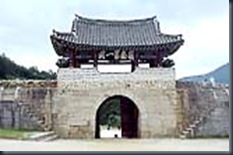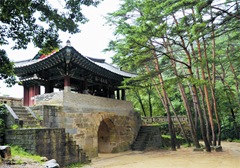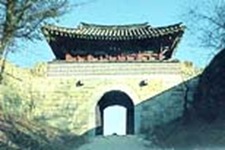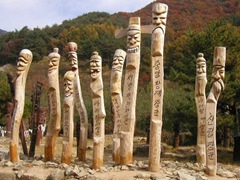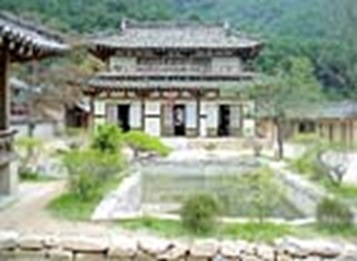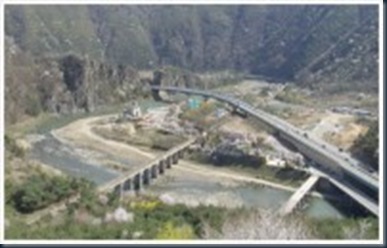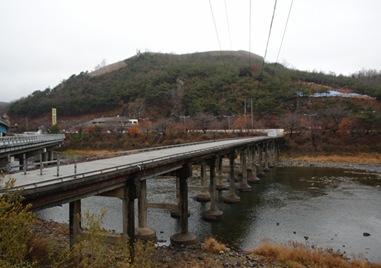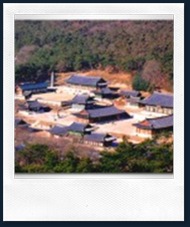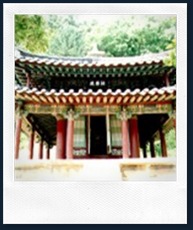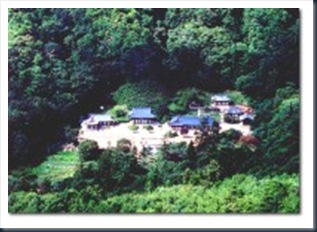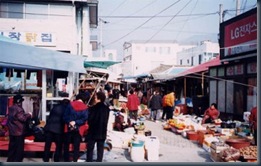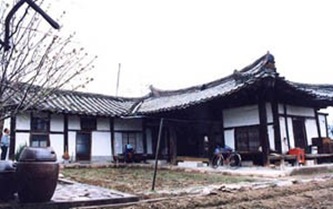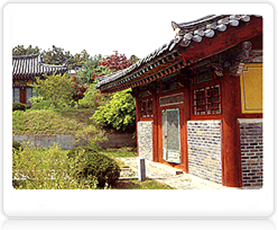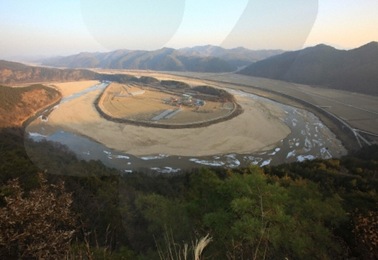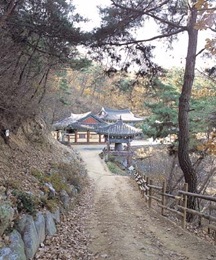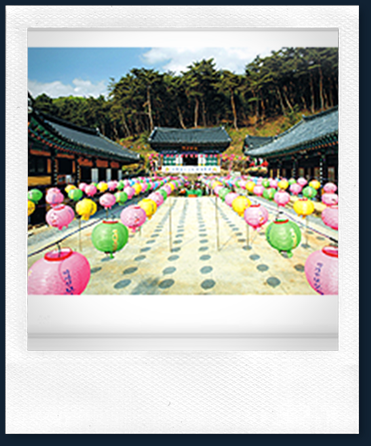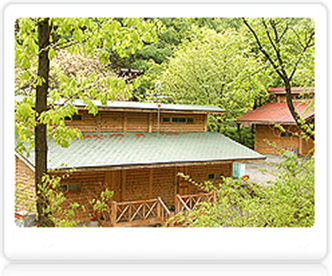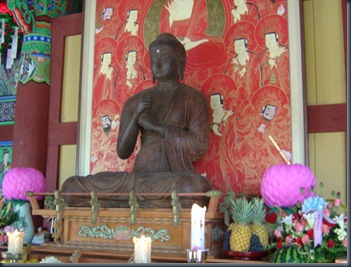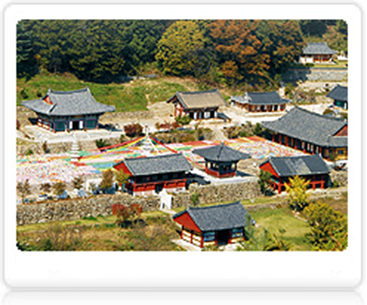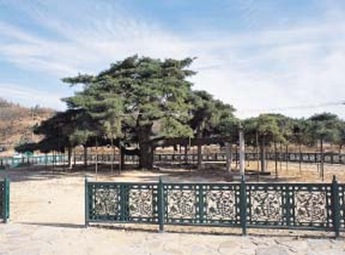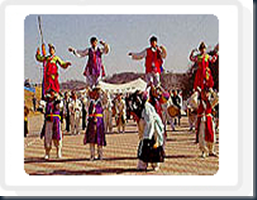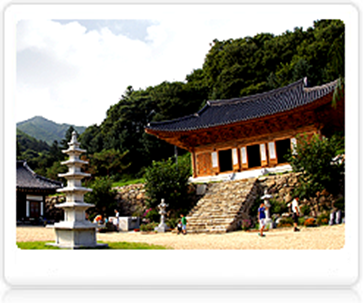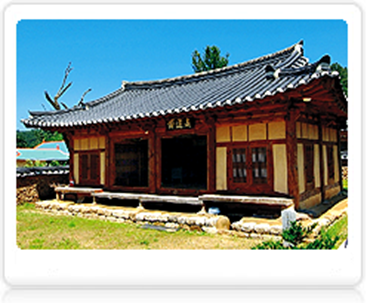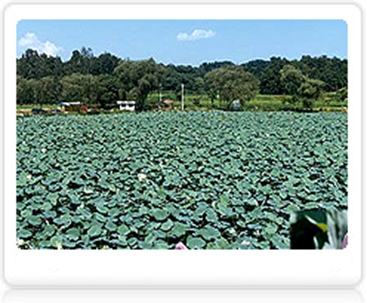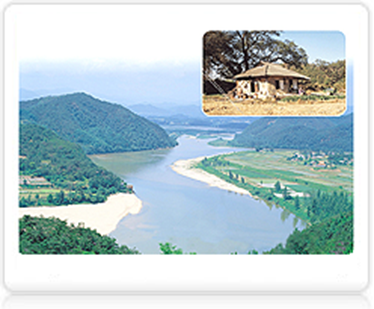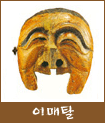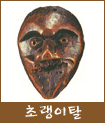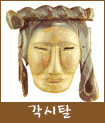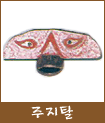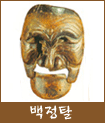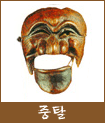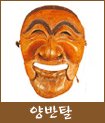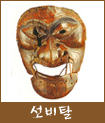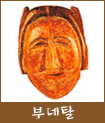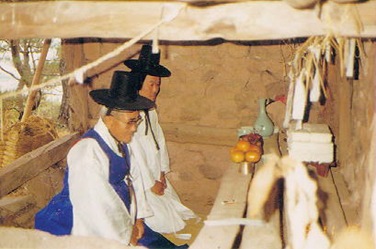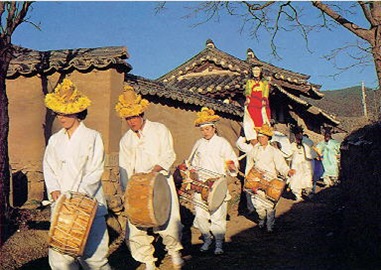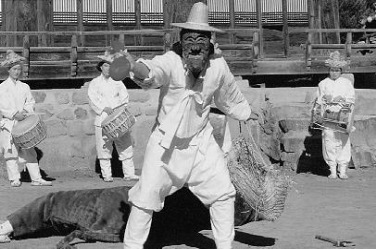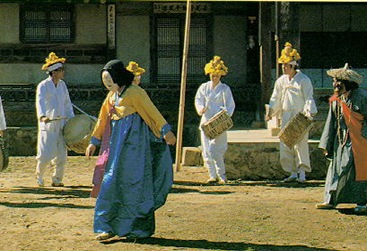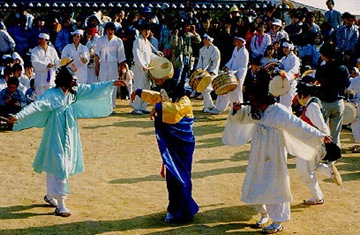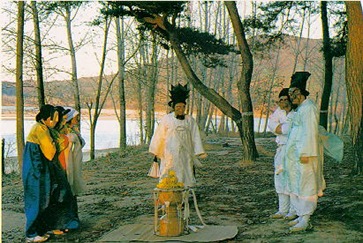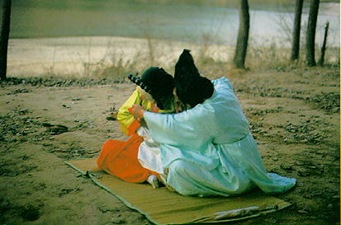To the west of Yecheon County, Mungyeong City stands on the border between North Gyeongsang and North Chungcheong provinces and is where we will be heading for next. The Sobaek mountains form a line between the two provinces, the highest peak being the Munsu peak in Mt. Worak. The city's terrain cut by numerous valleys, slopes down from the Sobaek peaks towards the valleys of the Nakong River and its tributary, the Yeong. At their meeting-point in Yeongsun-myeon, the rivers are barely 200 m above sea-level. Above the valleys, the soil is thin and sedimentary bedrock is very common. Millions of years of erosion have created spectacular cliffs and escarpments in many areas, some of which have become major tourist attractions.
Mungyeong City is practically neighbours with Danyang County and Chungju City to the north, GoesanCounty to the northwest and Sangju City to the south. Mungyeong has a lengthy history and is well known for its various historical and scenic tourist spots. You will find the hub of the local activity to be centered on Jeomchon which is the principal town here. I shall skip the earlier history of Mungyeong to tell you how this came about. If you recall, the ROK was under military dictatorship from 1961 until 1991. At that time, Mungyeong was divided into two territories, Jeomchon City and Mungyeong County. The city only acquired its present-day borders in 1995, when the two former units were merged into one to form the present-day territory of Mungyeong City. The overwhelming majority of Mungyeong's people (approximately 99.7%) are ethnic Koreans, many of whom are from families with long and deep roots in the area. But nowadays the population in Mungyeong County is decreasing as more and more people, especially the younger generation are moving away to major urban cities such as Daegu and Seoul.
For those of you who are mountain lovers then Mungyeong County will certainly please you. When there are mountains there must be valleys, so on this trip we will be travelling over a lot of hills and dales. If I’m not mistaken, there are more than 30 mountains in Mungyeong County whereas the valleys are not that many, perhaps some of them are not accessible. Anyway the homepage recommends we visit a few of these valleys and mountains which we will do so. However I wonder if I can fit all that in one posting, you know, there are some very interesting legends connected with some of these mountains. Because the land in Mungyeong is mountainous, (roughly 75%) it is unsuitable for farming. Nonetheless, the agricultural sector continues to play an important role in the local economy. Some local produce is sold directly in the area, but most is exported to major urban centers around South Korea. Orchard farming, particularly apple growing plays an important role in its economy.
Just a bit about Mungyeong City before we go sightseeing. There are three museums in Mungyeong: the historical museum at Mungyeong Saejae, a ceramics museum nearby, and the Coal Museum in Gaeun-eup. Why coal museum? In the olden days coal mining used to be a means of livelihood in this area, but not now anymore. However the city officials are trying to convert the coal-mining tradition into a tourist attraction. Gaeun, was once the heart of the mining district, and that’s why the museum is there.
National Parks seem to be predominant in this county naturally because of its numerous mountains and valleys. The Songnisan National Park covers part of Gaeun-eup in the southwest. Mungyeong Saejae is itself a provincial park, covering a substantial area of Mungyeong-eup. Also covering part of Mungyeong-eup and a considerable part of Dongno-myeon is the Woraksan National Park.
Although Mungyeong is a city there is no airport here whereas a small airport with passenger service operates in neighboring Yecheon where we came from. Like most of the other rural areas in Gyeongsang province, the culture of Mungyeong is greatly influenced by Korean Confucian values. The city still retains ties with the traditional arts like the various Korean folksongs, including the Mungyeong Saejae arirang, which are distinctive to the district. However, the most intensely promoted art form in the district is Mungyeong's traditional ceramic craft, which dates back to the Joseon period and is still practiced by many master potters in the area.
Local cuisine, although broadly similar to South Korean cuisine in general, does have some local influence. The North Gyeongsang specialty jjim dalk, a spicy chicken and noodle dish, and Chuncheon-style chicken galbi are widely available here.
And now let’s start on our tour of Mungyeong. Our first stop is the Mungyeong Saejae Provincial Park. There are 3 legendary boundary gates at Mungyeong Saejae Provincial Park, on rough mountain tops, which are reputed to be too tall for even birds to fly over. Jungyeong Saejae, which overlays Mt. Joryeongsan, has always been the highest and most dangerous mountain pass. The boundary gates and castle walls were raised here after the Japanese Invasion of Korea and were used as fortresses for national defence. These three entrances, are called the Mungyeong Samgwan-mun (3 Entrance Gates of Mungyeong) and are all located on Juheul-san (1,106 meters) They were damaged after that point, but in 1966 the No. 1, 2, and 3 boundary gates and castle walls were designated collectively as historical relic No. 147 and were later restored in 1976. Take the big road beside boundary gate No. 1 ( Juheulgwan), for about 1.5km and you’ll arrive at the 3rd gate (Joryeongwon). There are only stonewalls left from the many inn-like dwellings, which were built to accommodate government officials on official tour. Past the tavern, which was restored in 1983, you’ll reach the 2nd gate (Jogokgwan.) The area around Jogokgwan is famous for its birch trees, and the Mungyeongsaejae Revolt Monument is on the left side of the road.
It’s 3km from Juheulgwan to Jogokgwan and 3.4km from Jogokgwan to Joryeonggwan, through a walkway with its harmonious scenery of rocks and cool streams. Instead of taking the big road, you can take the road with the sounds of stream water, to a waterfall. 30 minutes farther and you’ll arrive at Hyeguksa Temple.
Hyeguksa Temple is at the edge of Juheulsan, and is the place where King Gongmin (reign 1351-1374) took refuge from the war of Honggeonjeok at the end of the Koryo period. Past Hyeguksa Temple and the Royal Palace about 1km, you’ll reach the sacred peak of Mt, Juheulsan. The view of the winding mountain ranges from the mountain top is spectacular. From the mountain top, past the valley, is Jogokgwan. The 3rd boundary gate is at Juheulsan (1,106m), and it takes about 4-5 hours to get to Jogokgwan from Juheulgwan. The area was designated as a Provincial Park in 1981
Near the park’s entrance is a large collection of these Korean wooden carvings or changseung, (similar to totem poles) which are supposed to keep away evil spirits. I think I already spoke about them when I wrote about the Jangseong Park (Andong Part 2). There's a movie set of a traditional Korean village further up the trail.The tourist village is at the south entrance to the park where you can find restaurants, minbaks, and souvenir shops.
Let’s go into the museum, it looks very big and impressive. The Mungyeongsaejae Museum is just slightly over 12 years old and can still be considered quite new. It’s near the entrance to the park. It consists of three exhibition rooms. The 1st room Juheul is mainly about “Mungyeongsaejae”, here you can read all about the origin and early history of Mungyeong Saejae. The 2nd room Jogok is about “The Culture of Mungyeong,” It portrays the lifestyle of the Korean people, the clothes they wear, the food they eat, the houses they stay in, the religions they practice, their occupations and the tools of their trade. The 3rd room Joryeong is focused on “the cultural assets in Mungyeong,” it’s all about Chinaware in Mungyeong including those buried and excavated, and also old documents and paintings.
KBS drama studio is also located in this park, specializing in historical dramas, and claims to be the largest scale studio in the world. In order to film historical drama with the Koryo period background this seemed to be the ideal place, as physically, the Joryung Mountain and Juheul Mountain were very similar to Gaesung’s Songak Mountain. For the filming of Taejo Wang Geon they constructed 2 palaces (Koryo and Baekje), a 48 traditional Korean tile house complex to show the high class people's place of residence, and 47 traditional thatched roof houses to portray the look of the average people's living places, during the Goryeo Dynasty.
The Goryeo palace is as tall as a 7-story building and is based on historical investigation of the actual Goryeo Dynasty's palace site, Manwoldae.. The Mungyeong set is surrounded by Worak-san National Park and Juheul-san. To get to the set, go to the Mungyeong Saejae Management Office at Mungyeong-eup, past the Mungyeong Saejae Museum until you arrive at the first gate (Juheul-gwan). For the filming of King Saejong, they constructed the Gwanghwa door, the Gyeongbok palace, the Dong palace, Suhungwan, Gaksa within the palace, houses of the noble class and houses of the lower class. Besides Taejo Wang Geon and King Saejong, some of the KBS dramas that were filmed here were First King Wanggun, Morning of the Empire, No Man Period, Daejoyoung and Muinsidae (The Age of Warrior).
The No.1 scenery of the 'Eight Beauties of Gyeongbuk',. Jinnamgyoban shows the harmony between nature and artificial art. The Gwiam Odd-shaped Stone and the continuous precipitous wall of stratified rock and the three bridges, Cheolgyo (Railway Bridge), Gugyo (Gu Bridge) and Shingyo (Shin Bridge) over the river is just beautiful. During the spring azaleas and royal azaleas bloom profusely and is similar to the Geumgang mountain where it changes drastically according to the season, thus this place is known as the Sogeumgang of Mungyeong.
The home page of Mungyeong recommends eight places where the view is nice. It is a pity that the Bongamsa temple is off limits to the general public, being a chogye order special ascetic practice place, there are monks doing meditation and any visitors will be distracting for them. However visitors are only allowed in on Buddha’s birthday. The Bongamsa temple is set amidst very beautiful surroundings and there are so many treasures and cultural assets to be found inside the temple and temple grounds like the Geukrakjeon. Jeongjindaesa Wonotap, Jijeungdaesa Jeokjotap Jijeungdaesa Jeokjotapbi, the Bongamsa temple 3-story stone pagoda and the Maebosaljwasang at Bongamsa
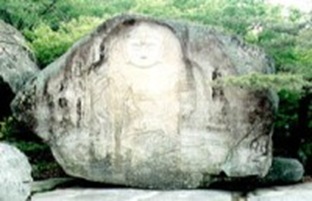 This Buddhist statue, the Maebosaljwasang is engraved on the surface of a large stone of 4m in height and 4.4m in width to the northeast from the streamlet of the place with the fine view called Baekundae.
This Buddhist statue, the Maebosaljwasang is engraved on the surface of a large stone of 4m in height and 4.4m in width to the northeast from the streamlet of the place with the fine view called Baekundae.
So we shall visit another temple instead. The Daeseungsa temple in Jeondu-ri, Sanbuk-myeon has a brilliant history in Korean Buddhism having produced many high priests. It was constructed by Mangnyeong Bigu in the 9th year of King Jinpyeong of Shilla. The main peak of Sabulsan Mountain is Gongdeokbong peak and engraved on the mid-slope of the mountain is a Buddhist, Sabulam statue.
In the temple you can find the Daeseongsa Yunpilam Wood Amitayeoraejwasang and Jigam.. The face of the statue is egg-shaped and it is different from the trend of the late Chosun Dynasty. And the shape of sacerdotal robe was completed relatively simple, and also full of Styx. The Buddhist statue was enshrined in a black niche delicately made with thick Korean paper. This niche seemed to be made after this Buddhist statue was made, which was also done a long time ago. Based on the trend of Buddhist statues, it can be said to have been produced in the late 15th or early 16th century, during the Chosun Dynasty. It is considered to be a valuable asset because of the rarity of small wooden Buddhist statues.
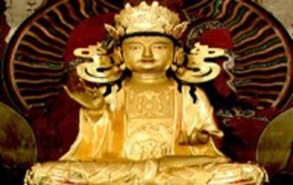 This statue of Buddha is called Geumdongbosaljwasang and is enshrined as the main Buddha statue in the monk’s room of Daeseungsa temple. It has been well preserved. On his head , he is wearing a splendorous metal coronet that was made separately. The surface is filled with various flowers and letters, and he is wearing Tugakhwamun on both sides. As the upper part right of the string knot is expressed at the center of the long upper body, it looks as if it divides the statue into two. These are also the unique characteristics of this statue of Buddha.
This statue of Buddha is called Geumdongbosaljwasang and is enshrined as the main Buddha statue in the monk’s room of Daeseungsa temple. It has been well preserved. On his head , he is wearing a splendorous metal coronet that was made separately. The surface is filled with various flowers and letters, and he is wearing Tugakhwamun on both sides. As the upper part right of the string knot is expressed at the center of the long upper body, it looks as if it divides the statue into two. These are also the unique characteristics of this statue of Buddha.
Now I’m going to introduce you to another one of the eight “nice views,” the Seonyudong Valley. It is composed of nine winding valleys filled with old evergreens and rock walls, and is also called Seonyugugok. Seonyudong Gyegok Valley’s large rocks are so naturally stacked together that they seem to be deliberately made. According to the legends, the mountain gods came down to this valley to enjoy themselves long ago. This valley has white rock bases in its lakes, and clear water flowing all year between the rock walls. The water falling on the huge rock walls are a sight to behold. On the lower parts of Seonyudong Gyegok Valley, you can see Chilwujeong, a pavilion built in 1927 by seven locals named Wueun, Wuseok, and others who all share the character “wu” in their names. Some say the name of the pavilion was given by King Uichin (reign 1877 - 1955). If you follow the valley, you will see occasional pavilions and characters written on rocks as well. The valley’s scenery has been much loved by many people in the past.
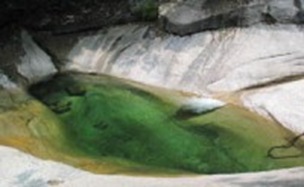 Yongchu Gyegok Valley is located in Mt. Daeyasan and it is a special place where the water does not dry up, all throughout the year. Mt. Daeyasan, which is located in Wanjang-ni, Gaeun-eup, is formed of sharp peaks and all different types of Giamgoeseok, and the waters that flow through the valleys do so all year long. It borders Chungbuk Goesan-gun and Gyeongbuk Mungyeong-si, and is located in Mt. Daeyasan (931m). The three-tiered Yongchu Pokpo Waterfall, located in Yongchu Gyegok Valley, is the place of legend where two female dragons rose up to the sky. Yongchu Gyegok Valley is divided into Upper Yongchu and Lower Yongchu. The place where the water falls out of the granite foundation down to where the heart shaped pond is, is Upper Yongchu, and below that point is Lower Yongchu. On either side of Yongchu, there are two large markings on the granite boulders, which are said to be dragon scale markings, made as they rose up to the sky. Even when other places are having droughts, water always flows here, so many rituals for rain were held here in the old days. Above the Yongchu Pokpo Waterfall, past the base rock, about 20 minutes away, you will reach Wolyeongdae. It was named so because of its lovely view of the moon reflected on the water flowing through the rocks in the valley below. Near Yongchu Gyegok Valley there is the Seonyudong Gyegok Valley, also called Seonyu Gyegok (a place of 9 sceneries) where the Okgyesu River runs through two great rocks, which look as if they have been artificially split.
Yongchu Gyegok Valley is located in Mt. Daeyasan and it is a special place where the water does not dry up, all throughout the year. Mt. Daeyasan, which is located in Wanjang-ni, Gaeun-eup, is formed of sharp peaks and all different types of Giamgoeseok, and the waters that flow through the valleys do so all year long. It borders Chungbuk Goesan-gun and Gyeongbuk Mungyeong-si, and is located in Mt. Daeyasan (931m). The three-tiered Yongchu Pokpo Waterfall, located in Yongchu Gyegok Valley, is the place of legend where two female dragons rose up to the sky. Yongchu Gyegok Valley is divided into Upper Yongchu and Lower Yongchu. The place where the water falls out of the granite foundation down to where the heart shaped pond is, is Upper Yongchu, and below that point is Lower Yongchu. On either side of Yongchu, there are two large markings on the granite boulders, which are said to be dragon scale markings, made as they rose up to the sky. Even when other places are having droughts, water always flows here, so many rituals for rain were held here in the old days. Above the Yongchu Pokpo Waterfall, past the base rock, about 20 minutes away, you will reach Wolyeongdae. It was named so because of its lovely view of the moon reflected on the water flowing through the rocks in the valley below. Near Yongchu Gyegok Valley there is the Seonyudong Gyegok Valley, also called Seonyu Gyegok (a place of 9 sceneries) where the Okgyesu River runs through two great rocks, which look as if they have been artificially split.
Want to buy some of those famous Mungyeong apples? It’s the specialty at the Mungyeong regular market in Ha-ri, Mungyeong-eup. But they only open for business six days in a month, on the 2nd, 7th, 12th, 17th, 22nd, and the 27th of every month. These Mungyeong apples come from the south of the Sobaek Mountains, where the weather is ideal and the limestone soil conducive for apple growing, so they are very sweet and juicy.
If you are looking for food there are a lot of places to eat everywhere so you won’t go hungry. You can get the names of the restaurants from the homepage.
 Porcelain made by masters and intangible cultural assets in Mungyeong that is famous for its traditional porcelain is being displayed at Porcelain Exhibition Hall. The Porcelain Exhibition Hall (Confucian Culture Hall) consists of the Porcelain exhibition room, the Suseok Exhibition room, the porcelain exhibition and sales corner, a rest room, a collection room, an office and the R & D room.
Porcelain made by masters and intangible cultural assets in Mungyeong that is famous for its traditional porcelain is being displayed at Porcelain Exhibition Hall. The Porcelain Exhibition Hall (Confucian Culture Hall) consists of the Porcelain exhibition room, the Suseok Exhibition room, the porcelain exhibition and sales corner, a rest room, a collection room, an office and the R & D room.
The “Korean Traditional Tea Cup Festival” is held here in May every year.
Mungyeong is the center of Suseok and is well known to Suseok lovers throughout the whole country. Suseok in Mungyeong has all the conditions such as transparency, irregularity and color. The Suseok Exhibition Room is especially dedicated to Suseok.
And now we are going to visit a few of the important houses in Mungyeong.The birth home site of Lee Gang Nyeont Wanjng-ri, Gaeun-eup, is worth a visit. It is the birth-home of Lee Gangnyeon who was general of the anti-Japan Civil soldiers. His family origin is Jeonju, nickname is Nakin and pen name is Ungang and he was raised at Wanjang-ri, Gaeun-eup, Mungyeong County.
He took office of Seonjeongwanby passing at military service examination in 1879 (the 16th year of the King Gojong), but he returned to his home town leaving the position behind when Gapshinjeongbyeon(happened in 1884 (the 21st year of the King Gojong). He performed anti-Japan activities for 13 years, and was conferred posthumous honors on Daehanmingukjang, metal for contribution to country establishment in 1962.
He wrote Ungangmunjipand, his pupils and followers compiled「Ungangseonsaeng Changuirok」.
House of Go Byeong Suk in Nokmun-ri, Mungyeong
This house is one of the old houses of the Gaeseong Go’s family living in Nokmun-ri, Mungyeong.
It was established by Go Mongik (1780 ~1851) who settled down for the first time in the early stage of the 19th century in 1828(the 28th year of the King Sunjo), and after then, his descendents had been lived there. But as it faced destruction in the end of the 1930s, the current owner has preserved it and managed it till now.
This house shows the construction trends in the 19th century well as Jungmun located in the front gate of Sarangchae, lots of receipt space, storage rooms, and low doorsill etc. Especially, the 8-edged roof of front gate building and the trend shown at upper part of center column of Sarangdaecheong are rare construction trend.
Well, guess that’s about it for now, see you next time.

